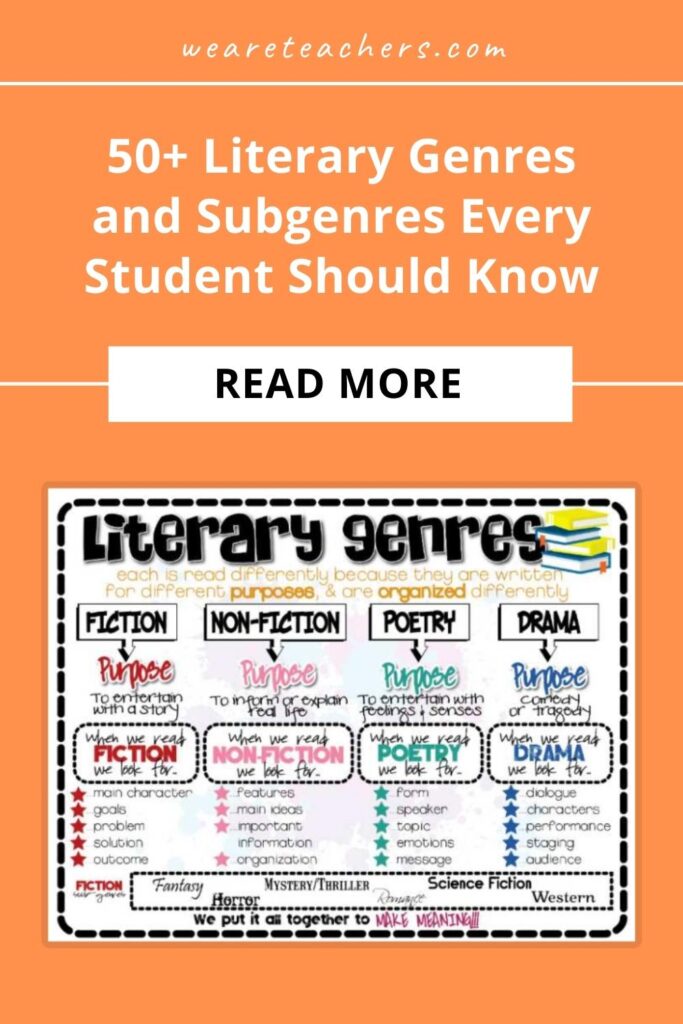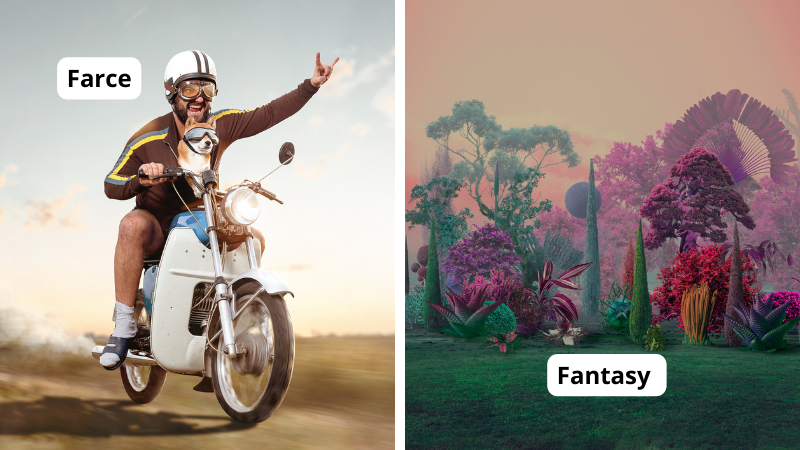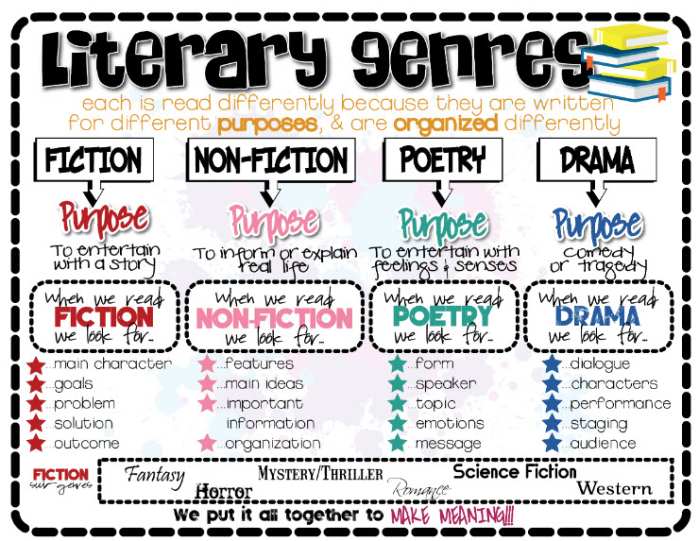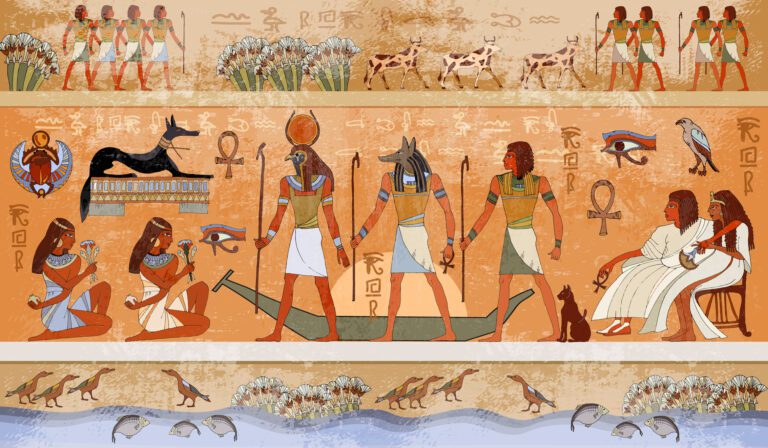Once kids learn to read, they unlock a very rich world of books and other writings to explore. This list of literary genres and subgenres offers definitions and examples for a wide array of writing styles. Encourage students to explore them all!
What are literary genres?
Source: The Chalkboard Unicorn
A genre (ZHAHN-ruh) is a category of literature in which the various works share certain characteristics. We often break writing into four main literary genres: fiction, nonfiction, poetry, and drama. (Some people consider fiction and nonfiction to be one category called prose.)
Each of the literary genres has its own set of subgenres. There’s no definitive list of literary subgenres, and authors regularly invent new styles. For our list, we’ve chosen common literary genres and subgenres that students should learn to recognize. This is not a complete list by any means.
Students should also understand that many literary works fit into multiple categories, so narrowing down the literary genres and subgenres can be difficult. Still, knowing these different types can help kids learn which types of books they enjoy most and make it easier to find more of them.

Stories, poems, and plays that tell imaginary tales are called fiction. The people and events may be completely imaginary or based on real people and events but in fictionalized form.
When fiction is written as it is spoken, it’s known as prose. If the structure includes a focus on rhyme and rhythm, we call it poetry. Prose fiction can be broken down into categories by its length.
Novel
We use the term “novel” to describe a long piece of fiction, often described as “book-length.” Graphic novels use illustrations to help tell the tale, while novels in verse are very long poems that tell a story.
Examples: Moby Dick by Herman Melville, Huckleberry Finn by Mark Twain
Novella
Novellas are shorter than full-length novels but longer than a short story. There’s no one accepted definition of the length of a novella; they generally range from 10,000 to 50,000 words.
Examples: A Christmas Carol by Charles Dickens, Of Mice and Men by John Steinbeck
Short Story
A short story tells a complete tale with a fully developed theme, but it’s shorter than a novel or novella. They’re usually about 10,000 words or less.
Examples: “The Gift of the Magi” by O. Henry, “The Story of an Hour” by Kate Chopin
- 50 Irresistible Short Stories for Kids
- 70 Great Short Stories for Middle Schoolers
- 50 Best Short Stories for High School Students
While fiction is one of the major literary genres, it can be broken down into many categories known as subgenres. These subgenres describe the style and/or subjects of the literary work. It’s important to note that many works of fiction can fit into multiple subgenres.
Bildungsroman
Also described as a “coming-of-age” book, the bildungsroman (German for “education book”) tells the story of a protagonist from childhood to adulthood. It explores their moral and psychological growth, and is often (but not always) written in the first person.
Examples: Great Expectations by Charles Dickens, The Catcher in the Rye by J.D. Salinger
Epic
Originally, this term was used to describe long poems that tell the story of a hero’s journey’s and adventures. Over the years, this term has evolved to include novels and plays that trace a person or family’s history over a long period of time.
Examples: The Odyssey by Homer, War and Peace by Leo Tolstoy
Fable
Fables are short stories that teach a specific moral. Aesop is the most famous author of fables; his tales often use animals to tell the story and state the moral at the end.
Examples: “The Tortoise and the Hare” by Aesop, Fables for Our Time by James Thurber
Fairy Tale
Fairy tales are highly fictionalized short stories that generally include magic and fantastical characters. They’re usually intended for children and often feature a protagonist who receives a “happy ending” and an antagonist (villain) who is punished in the end.
Examples: “Cinderella” by the Brothers Grimm, “The Little Mermaid” by Hans Christian Andersen
Fantasy
Fantasy works are set in imaginary magical worlds and include mythical creatures like dragons, witches, vampires, and more. Avoid confusing this genre with science fiction; remember that fantasy deals with the impossible, while sci-fi explores the possible. (The two are frequently combined, though, and many works have characteristics of each.)
Examples: The Hobbit by J.R.R. Tolkien, Harry Potter and the Sorcerer’s Stone by J.K. Rowling
Folktale
Folktales are similar to fairy tales but originally were passed down orally rather than being written down. Therefore, they often don’t have attributed authors. Many folktales have more realistic settings than fairy tales.
Examples: Paul Bunyan stories, “Headless Horseman”
Gothic/Horror
Stories that involve ghosts, otherworldly beings, and mystical happenings that cannot be explained rationally fall into the category of gothic or horror. These novels seek to cause a sense of fear in their readers. Gothic novels were very popular in the 18th and 19th centuries, and gave rise to horror writers like Stephen King.
Examples: Frankenstein by Mary Shelley, Jane Eyre by Charlotte Brontë
Historical Fiction
Any fiction writing set in the past, in a real place and time, fits the definition of historical fiction. The characters can be real people or imaginary ones living through the events of that time.
Examples: The Book Thief by Markus Zusak, The Good Earth by Pearl S. Buck
Legend/Myth
Legends and myths are ancient tales that explain early history or natural events, often using supernatural characters. Greek, Roman, and Egyptian myths remain popular today, though all cultures have their own myths and legends that have been passed down for hundreds or thousands of years. As most started as oral tradition, they rarely have attributed authors.
Examples: “Theseus and the Minotaur,” “Robin Hood,” “King Arthur and the Knights of the Round Table”
- 8 Egyptian Myths Students Should Know
- 10 Great Greek Myths Your Students Should Learn
- 16 Fascinating Greek Mythology Books for Kids
Mystery
In a mystery, the characters must solve a puzzle, usually a crime of some sort. Generally, the solution isn’t revealed until the end of the story. The reader can use clues to try to solve the mystery themselves as they read.
Examples: Murder on the Orient Express by Agatha Christie, The Westing Game by Ellen Raskin
- 21 Must-Read Mystery Books for Kids
- 20 Terrific Mysteries for Classroom Libraries
- Books Like Encyclopedia Brown for Mystery-Loving Kids
Roman à clef
French for “novel with a key,” a roman à clef (pronounced “roh-MAHN ah clay”) is a story about real-life people and events, thinly disguised as fiction. The characters are given fictional names, and other details may be changed slightly. The “key” is the hints the author gives the reader to help them make the connection between fact and fiction.
Examples: The Bell Jar by Sylvia Plath, Animal Farm by George Orwell
Romance
Any writing that primarily focuses on the love story between two (or more) people is a romance. These stories often have happy or emotionally satisfying endings, though some end tragically instead.
Examples: Pride and Prejudice by Jane Austen, The Fault in Our Stars by John Green
Satire
Satire ridicules a topic or person, in an attempt to provoke the reader into rethinking their opinions on the subject. They may use irony, caricature, parody, and other literary devices, and characters and plots are often exaggerated or extreme to make the author’s point.
Examples: Gulliver’s Travels by Jonathan Swift, Catch-22 by Joseph Heller
Science Fiction
Also called sci-fi, this form of fiction speculates about potential changes to the real world based on scientific principles. Many sci-fi works focus on space travel, parallel universes, and time travel. They often take place in the future or on distant planets or worlds. Generally science fiction is considered to be stories that are possible based on our understanding of science, while fantasy works include magic or other supernatural elements. The two are often combined, and many works fit into both categories.
Examples: The Time Machine by H.G. Wells, Flowers for Algernon by Daniel Keyes
Utopian/Dystopian
In utopian literature, the writer imagines a “perfect” world, while dystopian writing posits a dark and cataclysmic future or alternate present. In many cases, the imaginary world is initially presented as utopian, but as more details emerge, the dystopian elements become clear. Therefore, these literary genres are often lumped together.
Examples: The Handmaid’s Tale by Margaret Atwood, The Hunger Games by Suzanne Collins
The opposite of fiction is nonfiction, which focuses on information and facts about real people, events, and other topics. Nonfiction can be full-length books or shorter compositions like articles or essays. It also includes “how-to” writing like cookbooks and self-help books.

There are many categories of nonfiction, usually based on the topic or subject. Here are some common nonfiction subgenres kids should learn about.
Autobiography/Biography
A biography tells the story of a person’s life, usually from birth to death. When a person writes their own biographical work, it’s called an autobiography.
Examples: The Diary of a Young Girl by Anne Frank, The Immortal Life of Henrietta Lacks by Rebecca Skloot
Essays
An essay is a short nonfiction work on a specific topic. It’s usually a personal reflection on a subject, in which the author shares their own experiences and thoughts. Sometimes authors publish their essays together in collections as books. These collections can include essays on related topics or simply be a compilation of an author’s works.
Examples: A Room of One’s Own by Virginia Woolf, Walden by Henry David Thoreau
Expository Nonfiction
This catch-all category includes any nonfiction book that seeks to tell its readers about a specific topic. It often uses illustrations, diagrams, and quotes from original sources.
Examples: We Are Water Protectors by Carole Lindstrom, Freakonomics by Stephen J. Dubner and Steven Levitt
History
Any nonfiction book that focuses on real people or events of the past is a history book. Biographies and autobiographies can fall into this category, but histories usually encompass a larger group of people and their impact on contemporary events.
Examples: Hidden Figures by Margot Lee Shetterly, 1776 by David McCullough
Memoirs
While memoirs are similar to autobiographies, they differ in a few small ways. Memoirs don’t generally try to tell the entire story of a person’s life. Instead, they reflect on a person’s experiences during important parts of their life. They are nearly always written in the first person.
Examples: All Boys Aren’t Blue by George M. Johnson, I Am Malala by Malala Yousafzai
Narrative Nonfiction
In narrative nonfiction, the author tells the tale of a real person or event in a way that feels more like a fiction story. The information is factual, but the style is entertaining and engaging.
Examples: In Cold Blood by Truman Capote, Killers of the Flower Moon by David Grann
Travelogue
When an author writes about their travel experiences, we call it a travelogue or simply “travel writing.” Usually, the author recounts a specific trip or series of related journeys. They describe the people and places they see along the way, offering their own thoughts and opinions about these encounters.
Examples: A Walk in the Woods by Bill Bryson, The Mosquito Coast by Paul Theroux
Also called verse, poetry gives special importance to the use of words, imagery, and rhythm. Poems are individual works of poetry. Poems usually break down into lines and stanzas rather than sentences and paragraphs. They can be fiction or nonfiction and of any length from a few lines to an entire book.
We can break poetry into subgenres based on characteristics like rhyme scheme (or lack thereof), rhythmic patterns, subject, and more. Here are some common poetic literary genres kids should know. See their definitions and details here: 15 Types of Poetry to Teach Kids and Teens.
- Acrostic
- Ballad
- Blackout Poetry
- Blank Verse
- Cinquain
- Concrete Poetry
- Elegy
- Epic
- Free Verse
- Haiku
- Limerick
- Narrative Poetry
- Ode
- Sonnet (Shakespearean and Petrarchan)
Examples:
- 70 Must-Share Poems for Your Elementary Classroom
- 45 Terrific Poems for Middle School and High School
This literary genre includes plays, musical, operas, and operettas, written to be performed in front of an audience. Students often study plays in literature classes, reading them instead of seeing them performed. They can be short, or longer works broken into multiple scenes and acts.
While dramatic works can be nonfictional, they are usually fiction. Experts break plays and other dramatic works into multiple categories. These are the most common.
Comedy
Make them laugh! Comedies are light and humorous dramatic works. The Greeks and Romans used this term for plays where the hero faces adversity and overcomes it in the end. By Shakespeare’s time, comedies involved humor, silly situations, and happy endings all around, and that’s how we usually use the term today.
Examples: The Taming of the Shrew by William Shakespeare, The Importance of Being Earnest by Oscar Wilde
Farce
A farce is a type of comedy, with exaggerated characters and improbable situations. There’s usually a lot of physical comedy, with characters taking ludicrous circumstances and happenings very seriously.
Examples: The Comedy of Errors by William Shakespeare, She Stoops to Conquer by Oliver Goldsmith
Tragedy
A tragedy tells the story of a protagonist with a tragic flaw, which ultimately leads to their downfall. Tragedies can also relate terrible or sorrowful events, from the point of view of one or more characters.
Examples: Romeo and Juliet by William Shakespeare, Death of a Salesman by Arthur Miller
Tragicomedy
As the name implies, these dramatic works have elements of both comedy and tragedy. They can have sad or happy endings, or even those that are inconclusive. They often tell tragic tales, with enough humor to lighten the overall mood throughout.
Examples: The Merchant of Venice by William Shakespeare, Waiting for Godot by Samuel Beckett
History Play
Today, we use this term almost exclusively to describe Shakespeare’s plays about real historical people and events. These dramatic works were very popular during Elizabethan times.
Examples: Richard III and Julius Caesar by William Shakespeare
Problem Play
In the late 19th and early 20th centuries, playwrights began writing dramatic works to draw attention to social issues or problems. Henrik Ibsen and George Bernard Shaw are well-known for this subgenre.
Examples: A Doll’s House by Henrik Ibsen, Mrs. Warren’s Profession by George Bernard Shaw
We believe in encouraging kids to read all kinds of literary genres and books, including these 16 Banned Books to Read Before 12th Grade.
Plus, get all the latest teaching tips and ideas when you sign up for our free newsletters!









